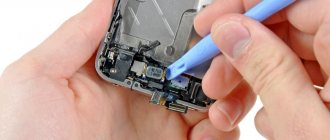Reasons for rebooting
Before diving headfirst into the problem, let's clearly define what bootloop is . Translated from English it means cyclic loading.
The Xiaomi logo appears , but things don't go further. The bootloader cannot do the main thing, the system does not start for some reason and everything repeats again.
Another possible option: a working phone suddenly turns off and reboots. There are no patterns in time. Once a minute or a day, a malfunction of the device may occur at the most inopportune moment.
The reasons for this disgrace in 95 cases out of 100 lie in the incorrect operation of the Android system software. What does it mean?
- It is corrupted by thoughtlessly editing system files after rooting. Fine tuning leads to thick circumstances. From the series: Don’t give the monkey a Kalashnikov.
- The update arrived by air, but it turned out to be “second-class”. There is no guarantee that the new version of MIUI will be bug-free.
- Independent actions to flash the device turned it into a brick. An OS was loaded that was incompatible with the device. Either the downloaded version has errors or is not for your device.
- The flashing process was completed by turning off the power. Cruel trouble. Although everywhere they write and shout about the need to pre-charge the battery, certain individuals manage to get themselves into this story. An update completed abnormally results in a cyclic dance with tambourines around the logo.
- As for viruses. Some are inclined to complain everywhere about a certain “hand” of Moscow (figuratively speaking). I admit that there is a virus inside the phone, but it can only do something nasty if you have root rights. Rare case.
- The installed application, just before the bootloop, turned out to be broken and malicious.
The remaining reasons are hardware in nature.
- Occasionally this is due to a low battery charge or a malfunction of the battery itself and the control circuits.
- The smartphone fell on the floor, water got into it, or a pet mistook it for its toy. In these and hundreds of similar cases, damage is possible, both mechanical and electronic.
- The chipset, RAM, and communication modules are damaged and need repair.
Why does my phone reboot during operation?
There are only three reasons why the gadget turns itself off and on during use. In the first case, most often, people install non-working updates.
In addition, the user, due to his negligence, can delete the axis file. The third reason is the installation of malware or a third-party application that causes the phone to reboot.
Solution
If a person installed some program, after which problems began to arise, then you can try to remove it. In such situations, applications have built-in viruses. Or the assembly itself is severely damaged. After this, you need to restart the device.
Rebooting may occur due to processor overheating. To prevent such problems, you need to let the gadget “cool down” after playing for 3 hours. You can also lower the processor frequency. To do this, download the “CPU Settings” program. Then open it and in the settings lower the mode by 2 or 7 percent.
If these options do not help get rid of the problem, then you need to install new firmware.
In most cases, such a solution, as users of the PDA forum claim, will eliminate the problem. You can use the new firmware on Xiaomi modifications. Their list includes Redmi Note, Plus and Pro.
What to do when a reboot loop ends at the MIUI logo
I don’t want to brag, but I have some experience in “lifting” Xiaomi phones from my knees. I don’t recommend taking on this matter hastily; nothing will come of it.
Still, certain knowledge must be present. Otherwise, you can simply finish off the smartphone; not every workshop will undertake to eliminate other people’s jambs, due to the fact that the process of restoring the device becomes many times more complicated.
Let's start resuscitation.
The best thing you can do, if, of course, you are sure that the firmware was not damaged and the bootloop occurred for a different reason, is to turn off the smartphone and enter the recovery menu. We press the volume + and - keys together with the power and find ourselves in TWRP. Naturally, it must be installed in advance, along with the unlocked bootloader. Select wipe data and do a full factory reset.
This procedure helps devices with an undamaged operating system. Returning it to "out of the box" condition solves all problems. Unfortunately, it cannot always be applied. You cannot do this procedure on stock recovery.
The next point is to make sure there is a charge in the battery, otherwise connect the charger. After charging, turn on the smartphone again. If the reboot fails, there are not many options left.
Reflashing the device.
Or rollback to an old working version, especially important in case of an unsuccessful update. But there are too many conditions that may not be collected at the right time.
- unlocked bootloader;
- installed TWRP;
- backup made on time, version of the working OS.
If you have everything listed, then there are no problems, go into recovery and restore the backup.
I didn’t have such an opportunity and had to harness myself to the fullest. The flashing procedure for Xiaomi phones online is described in detail; in this article I only mention it as the main method of solving the problem. You will need the Mi Flash flasher program, device drivers and the firmware itself.
In especially severe cases, when the device is not detected on the computer, you will have to use the SP Flash Tool and Qualcomm USB Driver.
But if nothing happens, the Mi logo is on and nothing else happens, then the question of returning to working condition is very pressing. A failed procedure with the firmware will lead you to the only solution: contact the service center.
Reason 4: software error
A malfunction may also occur after updating or changing the firmware.
Solution: rollback or reset
If the problem appeared after installing a new firmware or update, you should roll back to the previous version. In this case, a rollback is usually only possible when installing custom firmware. Resetting the settings often helps solve the problem on the factory firmware.
When the device constantly reboots after a few minutes of operation
Analyze your actions, when it started and what caused the bootlap.
Unsuccessful experiments with superuser rights and thoughtless actions with system files sometimes lead to disastrous results. The device begins to glitch and periodically turn off. Revert your settings to their previous state and restore changed system files. If an application was installed, remove it; it probably contains a virus. Coupled with root rights, it can independently ruin the OS.
If the device turns off during the game, it is worth checking the processor temperature and its frequency during startup and the game itself.
Some applications help control the heating inside the smartphone case and promptly alert the user about it. You are required to monitor the situation and draw a conclusion about this or that running game. Perhaps it is too “heavy” for your version of the smartphone and you should get rid of it. The Cooler Master application from the Play Market is suitable for this purpose.
The same applies to the load on the processor itself and its overclocking to critical values. This may cause the device to turn off. Install SetCPU, the Russian version, and using superuser rights, make the necessary changes in the operation of the chipset, and specifically, reduce the clock frequency.
Don't forget about flashing - suitable for any manifestations of bootloop. What to do and how to proceed is up to you to decide. It’s worth trying to switch to stable firmware, abandoning the developer one. This will clarify the root cause of the failure of the smartphone.
The strategy here is this: flash the device, do not install any applications, and at the very minimum processor load, observe the operation of the device.
If the phone reboots again, then it’s time to look at the following circumstances.
The main reasons why applications crash on Xiaomi Redmi
Before moving on to solving a problem, you need to understand its causes. It is worth understanding that they can be either software or hardware. In the first case, constant application crashes are associated with poorly optimized software for a specific smartphone model. In the second case, games are most likely minimized due to the user's fault. Below are the most popular reasons:
- Incompatibility of the program with the operating system. This can be observed when a person tries to install an application designed for Android 7 on Android 4.
- Poor optimization of the add-on. Some developers don't bother setting up the program for all devices. Usually there is a version suitable for the most popular phones. Also, opposite a similar utility on Google Play you can see the inscription: “Not compatible with your device.”
- Apk file corruption. This problem occurs when downloading software from third-party sites. During the assembly of the package, certain errors may have occurred that affected the further operation of the program.
- The cache was not unpacked correctly. Sometimes when installing games from third-party sites, you need to unpack the cache into a specific folder. Most users ignore this requirement, which is why errors occur in applications.
- Lack of RAM. Modern games are quite demanding on the performance of smartphones. It is recommended to carefully read reviews of the downloaded software and see how it works on different devices.
- Presence of viruses. Some Trojan programs may conflict with the software installed on the smartphone. We recommend scanning your device monthly using antivirus software.
More than half of the problems presented can be avoided. To do this, you need to stop downloading software from third-party portals and use only the Play Market.
Alternative causes of loading loops
These are hardware reasons, there may be quite a few of them. Xiaomi restarts if there are malfunctions in the chipset, memory, both RAM and full, communication modules. In a word, when your motherboard is acting up.
It is extremely difficult to diagnose it, like other possible breakdowns in the phone, at home. This will require you to have special equipment and, more importantly, specific knowledge at the intersection of different areas. This is programming and electronics.
Even the battery will require a clear answer from you about its serviceability. Not to mention the charge controller. For a comprehensive answer to all the questions posed, there is only one way out.
These tasks are best handled by craftsmen from specialized repair centers, which are located in any large populated area.
Reason 1: Power button is pressed
Frequent use or excessive pressing of the power button will lead to failure over time. Usually the button is pressed in and makes a contact, which causes the phone to constantly turn on/off. A typical malfunction of the button is a weak or absent movement when pressed, as well as a reaction to pressing when pressed with force.
Solution 1: Repair the power button
If the problem is with the button, you need to repair it yourself or take it to a workshop.
Solution 2: replace or modify the cover
Often, a case without open buttons causes the power button to be pressed. The dense structure of the case puts pressure on the button, which leads to a problem. Therefore, if the problem does not occur when removing the phone from the case, then the case should be replaced or a hole for the button should be cut.
Solutions
To stop Redmi 4 from spontaneously rebooting, it is most practical to use service services. The technique is especially relevant if the gadget’s warranty period has not expired. If the established period has ended and the costs of paid service by specialists are not desirable, then you can try to fix the problems yourself.
The most effective option is to use a backup copy of information, which is recommended to be updated periodically for unforeseen scenarios. If you have a backup, then you should go to improved recovery and delete all files from the smartphone’s memory, excluding the one where the recovery data is located, and then check if there is a problem. It is worth noting that you should not accept incoming notifications about updates received from the developer, since xiaomium.ru recommends waiting for the release of the most stable version of the system.
If there is no backup copy of personal information, you must remove the microSD and transfer all content to a PC or external drive, and then reinstall the software. As a result, it will not be possible to determine the specific cause of the problem, however, it is most likely to be eliminated.
Before taking drastic measures, such as reinstalling the system, you should fully restore the battery charge. First of all, it eliminates the chance that the root cause was a battery failure, and loading new software requires maximum energy. If in the end the problem is not resolved, provided that all available methods have been checked, you will have to contact the service for the appropriate services.











